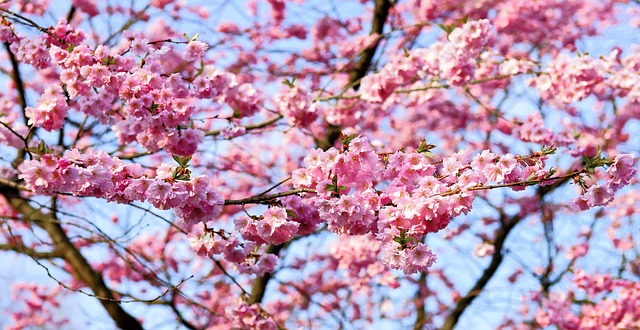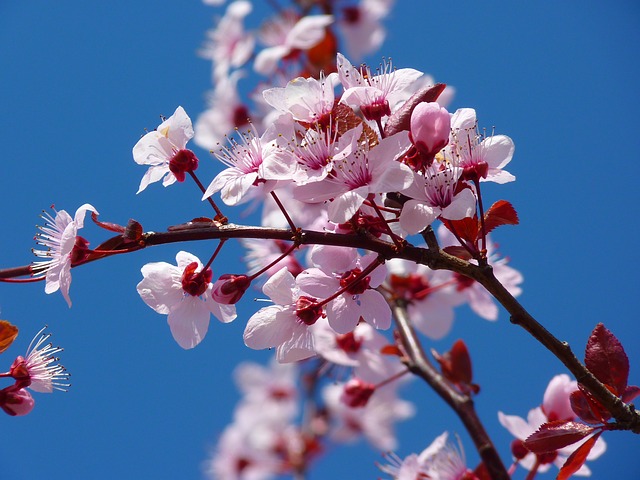Flowering Cherry Trees for Mediterranean Climates

Gardening Question from Faith:
Just came across your website–I am considering planting a flowering cherry tree so timing is perfect. I live in Southern California. Could you tell me if there is one that would grow well here and also about the rooting system and size of that type of cherry tree. I would like an ornamental size tree (not a shrub). I would be much appreciative if you could provide information to me.
Thanks much and have a wonderful day.
Answer from Pat:
You do not mention which Sunset Climate zone in which you are located. If you do not already know that, your first step is to find that out because most flowering cherry trees perform best in interior zones where they get some winter chill. You need to be sure that you plant a tree that will flower well in your zone. If you live in Sunset Zone 24 (in the fog bank near the beach) your choice is pretty well limited to the Taiwan Flowering Cherry (Prunus campanulata), which for many years has been an excellent choice for anywhere in Southern California. It is a delightful tree, upright growing and densely branched but with a graceful shape, and if I were you I would choose this one. Another possibility is P.s. ‘Pink Fair’, which has single flowers and good fall color. If you live in Sunset Zone 23 your choices are increased with ‘Dream Catcher’ and ‘Okame’ and if you live in Zone 20 or further inland from that, you have many choices, too many for me to discuss here. In that case I would look at the lists and descriptions you will find in Sunset Western Garden Book under “Prunus'”. But Taiwan Cherry is a winner anywhere in Southern California.
Flowering cherry trees need fast-draining soil that’s well-aeriated, in other words not hard compacted clay. You can easily provide this by building a raised bed. Even 4 inches off the ground is plenty of height. Then amend the soil inside to a depth of one foot. If your native soil is alkaline clay, also dig gypsum into it while you are amending the bottom layer. Then fill the bed with good quality top soil to raise the level of the soil but be sure to incorporate some of it with the soil below before filling all the way so you do not create hardpan.
PS: I neglected to answer you regarding the size of the tree. Taiwan cherry, like all ornamental cherry trees is classed as a small tree. but you can expect it to grow to be 25 feet tall and wide, unless kept smaller by pruning.



Hi Pat:
I have a couple cherry trees in my front yard. They both get all day sunlight. I deep water once a week. One of the tree’s leaves always look wilted and now many are turning brown, drying out or dead. The other tree looks much better. Is this part of winter dormancy? I live in the LA County area of Southern California.
Thank you!
Bonnie
This is the time of year (autumn) when you need to water less and allow your deciduous fruit trees to go into dormancy and drop leaves.
Wilting during the active growing season could mean your tree is growing in very fast-draining soil. Is your soil perhaps decomposed granite or very sandy? Unfortunately, some sandy soils in Southern California actually shed water and apparently deep watering may be only water-logging a few inches on top. The best solution for this is to use and organic wetting agent. Decomposed granite soil is a different kind of soil, not sandy. It is full of minerals and excellent in many ways for example, somewhat acid, but with very fast drainage, and it is also found in some parts of LA county, especially in the alluvial fans at the base of mountains. Decomposed granite needs to be amended heavily with organics, such as a cover crop, bean straw or well rotted compost, prior to planting or it cannot retain water. If that was not done, regular mulching can help retain moisture in soil. If once per week watering doesn’t work, a drip system watering more frequently might help but it would need to be beneath the mulch or it would only get the mulch wet.
where can yu buy these taiwan trees in so cal
I suggest looking online for a tree from Monrovia Nurseries though I have not checked to see if they carry this tree. Also, ask your nearest good nursery to order a tree for you.
I live in ventura county (ventura) and I would like to plant the Taiwan Flowering Cherry (Prunus campanulata) as its recommended for coastal area but I cant find it anywhere to buy it. Do you know of any place that sells the tree within a reasonable driving distance (here in So Cal reasonable driving distance in most part of the USA is more like a trip across 3 states lol).
This tree should be available during bare-root season if you order it at a fine nursery. Monrovia Nursery no longer grows this tree so that maybe why you are having trouble finding a specimen. Other ways to access this tree are 1. Phone the Dave Wilson company (look online for phone numbers and locations) and ask them to ship this tree bareroot to you in January or to tell you where to purchase it. 2. Contact the Los Angeles Arboretum for the same information. 3. Contact other botanical gardens that have plant sales such as, for example, Huntington Gardens.
Hi, Pat
I live in Rancho Palos Verdes, and was looking to purchase a Weeping Cherry Blossom tree but not able to find a nusery online who will ship to California, something about California Agriculture dept won’t allow it, and that I’m in zone 11. What’s your take? Am I going to be able to get this tree.
What about Kwanzaa Cherry?
Thanks for your reply
Try Surinam Cherry (Prunus campanula). It is successful in most subtropical zones. This one will bloom even in sight of the ocean.
Hello Pat, I live in zone 9B, Sacramento California. Our summers are pretty warm, with temps reaching the high 90s to a little over 100 during July and August. Our winters are cool. I am considering a flowering cherry, dream catcher variety for my front yard. My landscaping is primarily lava rock and I do not want a tree that will be messy or drop fruit or seeds on to my nearby concrete patio or steps. Can you tell me if this dream catcher variety produces fruit? Would you consider it a messy tree? Thank you.
“Dream Catcher” is a good variety from Monrovia Nursery with some resistance to pests and diseases. It tends to be upright and vase-shaped rather than spreading, roughly 15 feet tall and wide when full grown. Yes it will most likely produce small fruits that are red to begin with then turn black but they are insignificant, so usually not a bother. I would never call it a messy tree since leaf drop is in autumn and all at once, not throughout the year. You will get some fall color first. It would be good if you could see one of these trees growing and ask the owner how it performs for them.
Hi Pat! Thanks so much for hosting these questions. I live in zone 18-19 what are my best options for the beautiful flowering sakura for this area. Also, is it too late in the season to plant right now? I was planning to head over to Monrovia Nursery unless you have another recommendation for the west San Fernando Valley of Los Angeles. Many thanks.
The name “sakura” is a common name derived from the Japanese name for flowering cherry trees (Prunus serrulata). Yes they are well adapted to growing in Zone 18 as long as you provide good drainage and choose a disease-resistant variety. There are several varieties. ‘Kwanzan” is currently one of the most popular. It’s vital that you choose the best variety for your climate zone and one that is resistant to blight and bacterial canker. I suggest you ask the people at Monrovia Nurseries for their recommendation.
A book first published in 1982, “Flowering Plants in the Landscape”, edited by the late, great Mildred Matthias, strongly recommended Taiwan cherry (Prunus campanulata) as a better and more spectacular choice for Southern California than Prunus serrulata. Years ago I agreed, but today I am not so sure since newer varieties may have been developed that are better choices.
Finally, no I do not recommend planting this tree now. I know you are excited and eager to get on with this but I advise waiting until next fall or winter to plant.